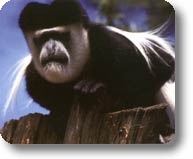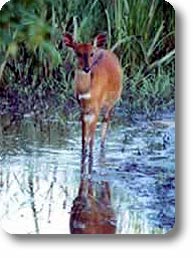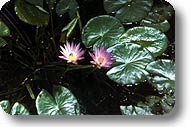


|
Saiwa Swamp National Park protects its resident population of Sitatunga Antelope (Tragelaphus spekei), which are believed to number as many as 100 animals. Belonging to the larger antelope family, the Sitatunga is uniquely adapted for its favoured wetland habitat. The only other known Kenyan populations are in the papyrus swamps of Lake Victoria and the Kingwal Swamp near Kapsabet.
Crepuscular and extremely shy, these antelope hide in papyrus and almost submerge themselves when alarmed. Sitatungas have brown coats, transverse white stripes on their backs and elongated splayed hooves which enable them to walk on the surface of the swamp. The males have twisted horns.
Look for the nocturnal Pottos (relatives of the Bushbaby), Spotted-necked Otters, giant Forest Squirrels, the black and white Colobus Monkey, Bushbuck and Bush duiker, as well as small groups of De Brazza’s Monkeys (Cercopithecus neglectus).
Birds
Birdlife is abundant. Waterbirds include the Lesser Jacana, Grey Heron, and African Black Duck among others.
The forests shelter the Narina Trogons, one of Kenya’s most spectacular forest birds. Watch for the Collared and Orange-tufted Sunbirds, sipping nectar from the flowers of the forest edge. The Yellow Bishop often whirrs above the reeds, its blazing yellow back on display. Hartlaub’s Marsh Widowbird also frequents the rushes. Noisy Ross’s Turacos are difficult to miss while the Paradise Flycatcher and the lovely Black-headed Gonolek are easy to see along the trails.
Ludher’s Bush-shrike is much shier while the Square-tailed Drongo and the Double-toothed Barbet perch in the lower branches of forest trees. Cinnamon-chested Bee-eaters abound, as do Crowned Cranes, especially when the surrounding farms are ploughed or harvested.
|
| Frogs and toads abound, with many different kinds of tree frogs trilling and piping after rainstorms. Bell's hinged tortoise, a forest-dwelling species, is found in the park and the blue-headed tree agama lizard is sure to cross your path. Snakes include the forest cobra and African rock python. As you follow the trails, watch for a side-striped chameleon. They are common, but easy to overlook due to their excellent camouflage. |
 |
Within this tropical wetlands and mosaic of riverine forest, sedges and acacia woodlands, with fringing dense rushes and grass beds, are some of Kenya’s loveliest terrestrial orchids. The bronze and purple Eulophia horsfallii, the fleshy pink Satyrium crassicaule and the crimson Satyrium sacculatum orchids abound, including the comet orchid, with greeny-white flowers fading to peach. Epiphytic ferns flourish.
The wetter riverine forest is marked by spreading afzelia trees and gigantic strangles figs (Ficus). Syzygium trees, with their dark-purple fruits, are not uncommon along the edge of the swamp.
|

